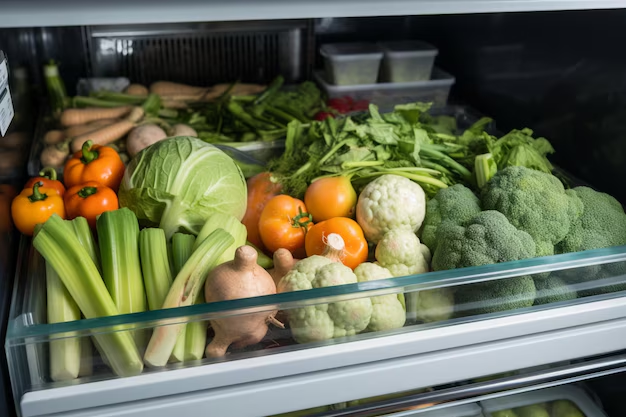Mastering the Art of Keeping Vegetables Fresh in Your Refrigerator 🌿
Keeping vegetables fresh and crisp for as long as possible is a common kitchen challenge. Yet with the right approach, your veggies can maintain their freshness, flavor, and nutritional value significantly longer. Whether you're tired of soggy lettuce or shriveled carrots, understanding the essentials of vegetable storage can be a game-changer for your culinary life.
The Basics of Vegetable Storage in the Refrigerator
To start with, temperature control is vital. Vegetables are sensitive to temperature changes, and ensuring your fridge is set to the ideal temperature range of 32°F to 40°F gives your greens the best chance at longevity. Most refrigerators have a built-in crisper, designed specifically for storing fruits and vegetables, which usually maintains a higher humidity level that's ideal for leafy greens and others.
🌽 Types of Vegetables and Their Storage Needs
Different vegetables have different storage needs, and understanding these can help you make better decisions about where and how to store each type:
- Leafy Greens: These benefit from high humidity. Store them in the crisper drawer, ideally wrapped in a paper towel to absorb excess moisture.
- Root Vegetables (e.g., carrots, radishes): These prefer slightly lower humidity and can also be stored in the crisper.
- Fruit-bearing Vegetables (e.g., tomatoes, peppers): For optimum freshness, store them on a refrigerator shelf rather than in a drawer.
- Alliums (e.g., onions, garlic): These prefer dry surroundings. They keep better when stored in perforated bags or left in open air compartments away from potatoes, to avoid sprouting.
🌟 Quick Tip: Know Your Produce’s Ripening Behaviors
Some fruits and vegetables release ethylene gas as they ripen, which can accelerate ripening (and spoilage) in others. For instance, bananas and apples are notorious for this. Keep such produce away from others unless you wish to ripen them faster.
Enhancing Shelf Life: Preparation and Packaging
Proper preparation can greatly extend a vegetable's shelf life. Here are some effective techniques to prepare your veggies for refrigeration:
🤲 Clean Before Storing
Pre-washing your vegetables can lead to mold or decay because moisture encourages bacteria growth. Instead, dry them thoroughly after washing. Utilize a salad spinner for leafy vegetables to ensure excess water is removed.
🥦 Optimize Packaging Techniques
Implement the right packing strategies to maintain freshness:
- Wrap leafy vegetables in a dry paper towel, then place them in a plastic bag or storage container.
- Root vegetables like carrots can benefit from immersion in water if you wish them to stay crisp; just ensure you change the water regularly.
- For vegetables like mushrooms, prefer a paper bag to a plastic one, as it prevents moisture accumulation and supports air circulation.
🍅 Use Airtight Containers
Airtight containers are champions in extending freshness. These help reduce exposure to air, which can degrade the quality of your produce. Ensure that these containers are clean and dry before use.
Using Technology and Gadgets for Fresher Veggies
Leveraging modern technology can also aid in keeping your refrigerator stocked with fresh items:
🌬️ Invest in Refrigerator Storage Solutions
Consider stocking up with specialized containers that maintain optimal humidity levels, designed to keep vegetables fresh. Some come with customizable vents for air circulation.
📦 Implement Vacuum-Sealing
Vacuum-sealing is a brilliant option for those looking to maximize the shelf life of their produce. By removing air, you reduce the risk of spoilage from oxidation and moisture loss.
🌡️ Smart Fridge Technology
If you've invested in a smart fridge, take advantage of its features—many come with applications that help you track the freshness of your produce and suggest optimal storage settings.
The Role of Organizing Your Fridge
Proper organization within your fridge can enhance efficiency in storing vegetables:
🗂️ Keep It Organized
Avoid overstuffing your refrigerator, as this limits air circulation which is crucial to maintaining even cooling. Label drawers or containers for better organization so you always know where everything is.
🌈 Categorize Based on Usage
Consider separating vegetables not just by type, but also by how frequently you use them. This approach makes it easy to access items and remember what needs to be used first.
🥕 FIFO Method
"First In, First Out" is a handy rule. Place newer produce at the back to use up the older stock first, which minimizes waste.
📝 Key Takeaways for Fresh Vegetables in the Fridge
- Ideal Fridge Temperature: Maintain between 32°F - 40°F.
- Humidity Matters: Use the crisper drawer for leafy greens.
- Separate Ethylene-Producers: Keep apples and bananas away from other produce.
- Pre-Wash Caution: Dry thoroughly after washing.
- Use Airtight and Specialty Containers: Prevent exposure to unnecessary moisture and air.
- Adopt FIFO: Organize produce to use older items first.
--
Keeping vegetables fresh doesn't have to be an overwhelming task. With the right know-how, a bit of preparation, and strategic use of fridge space, you can enjoy crispy, delicious produce longer. Thrive on the satisfaction of reduced waste and enhanced flavor, reaping the benefits well-stored veggies provide in our daily meals. 🥒🥕
